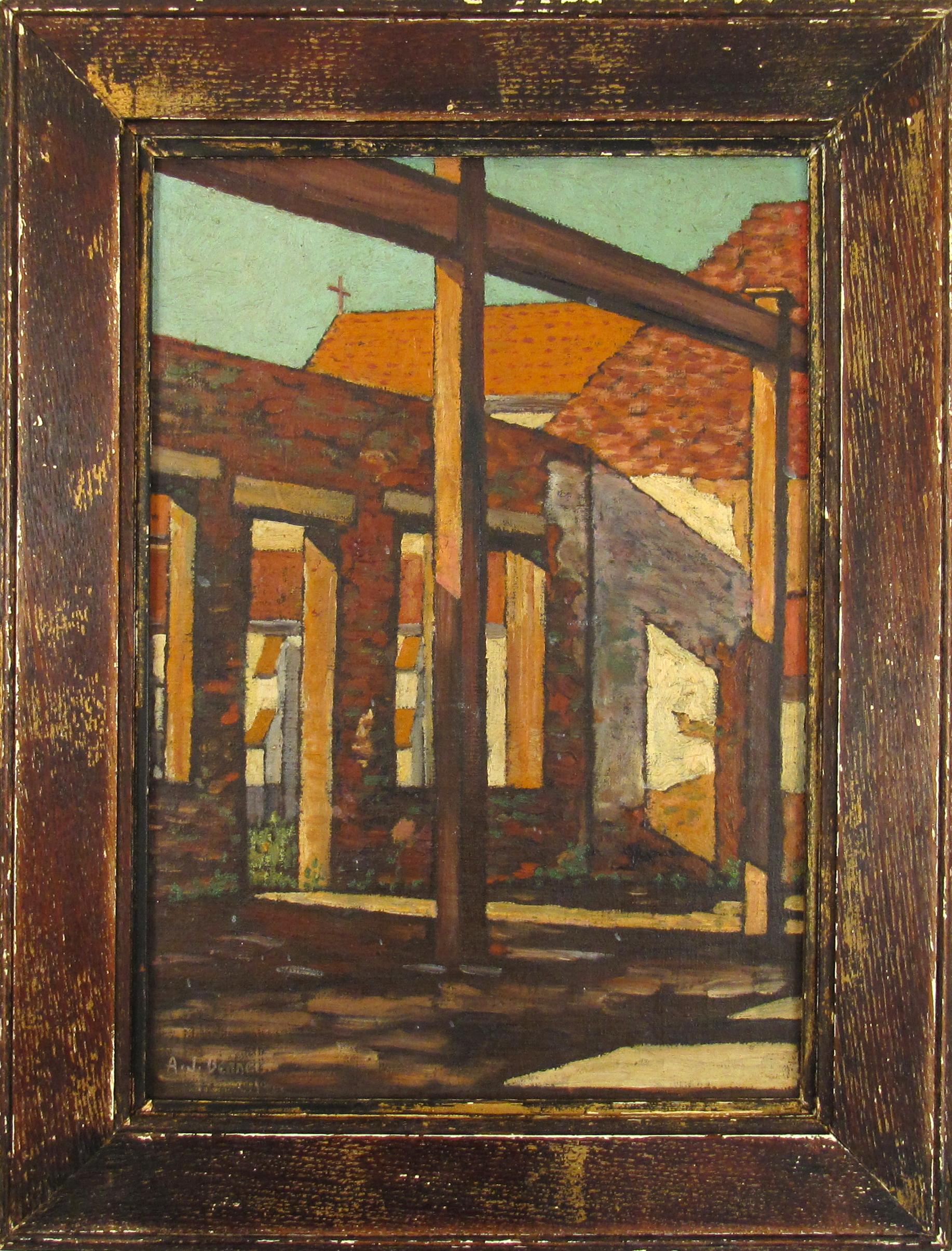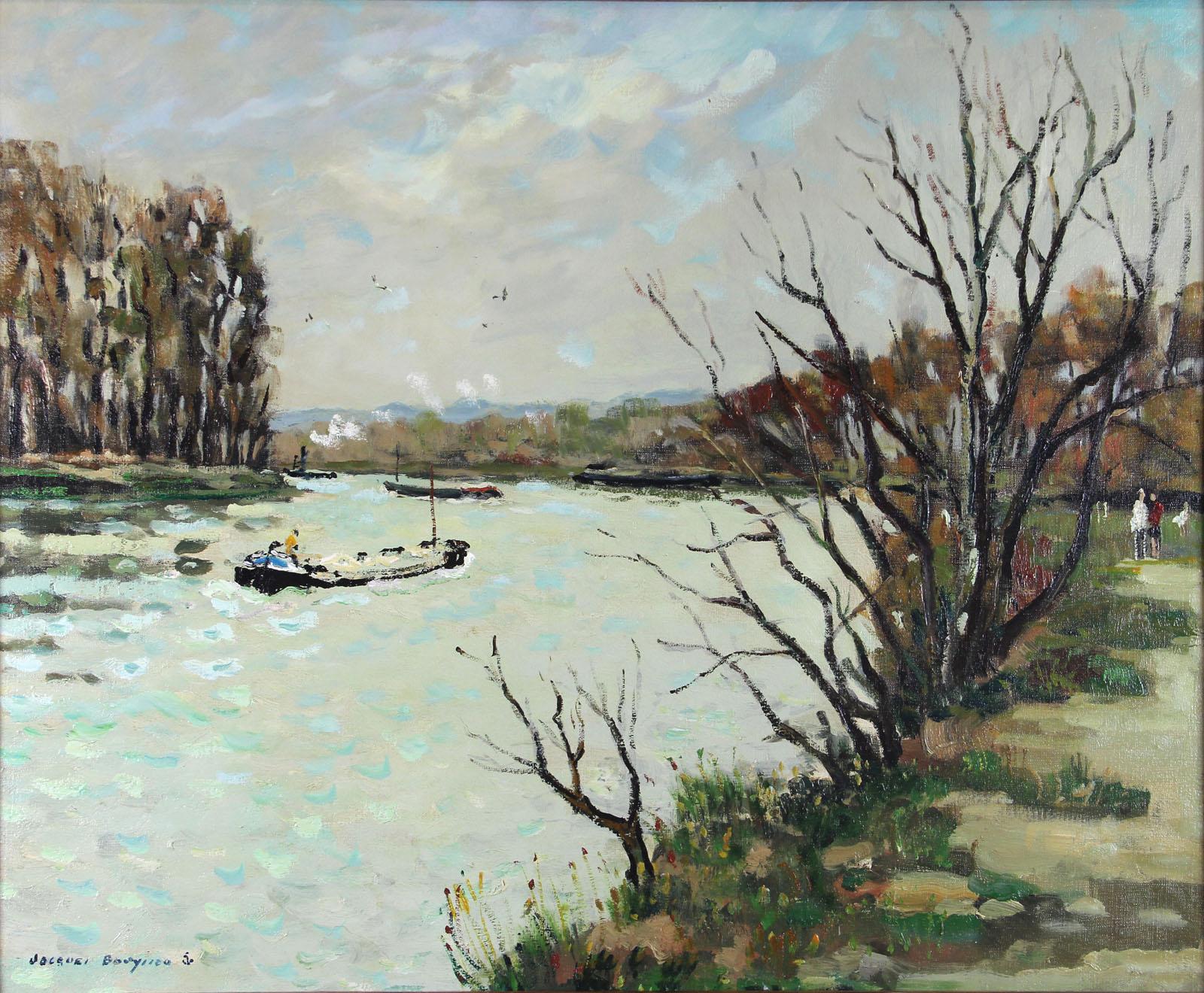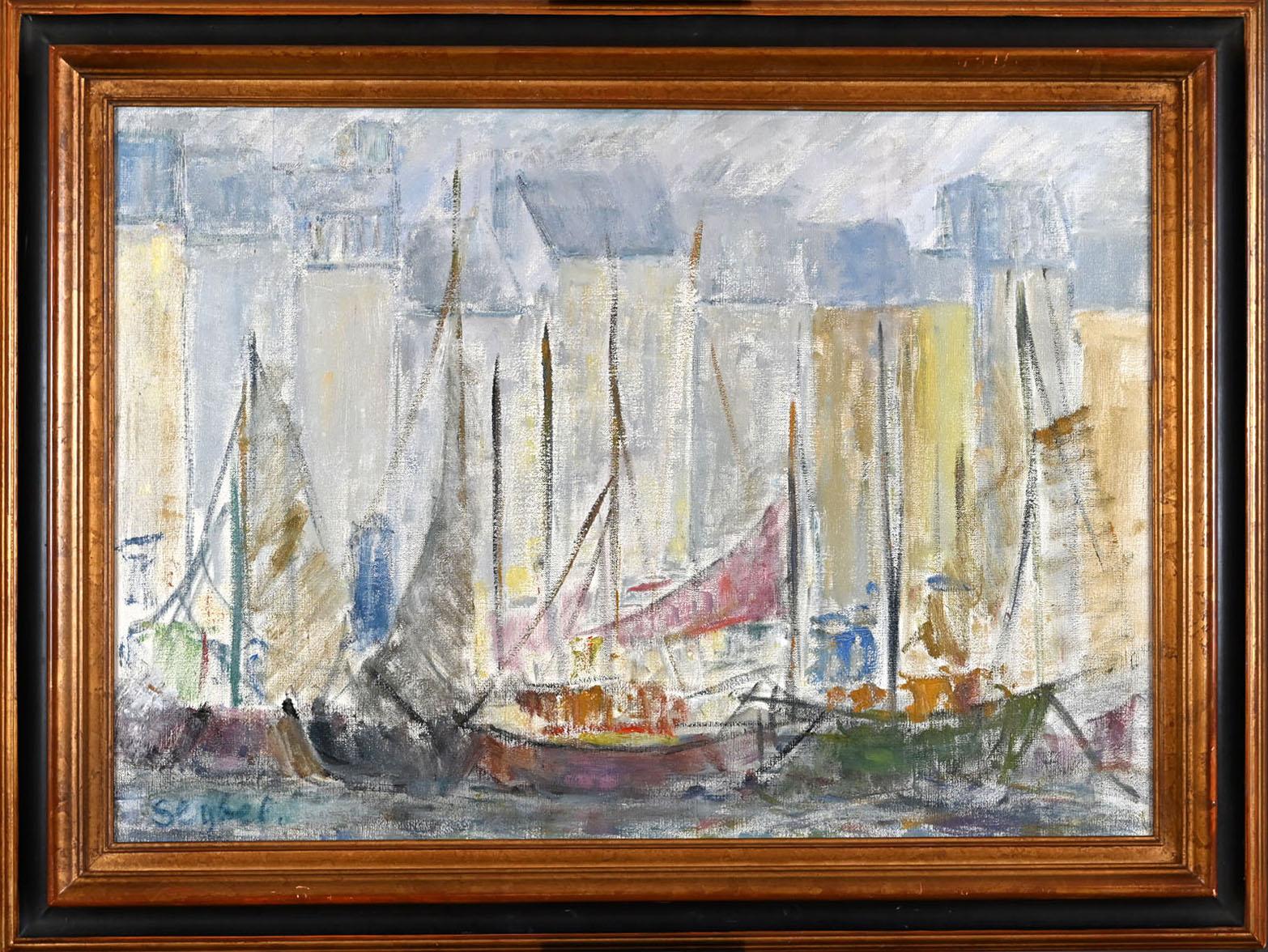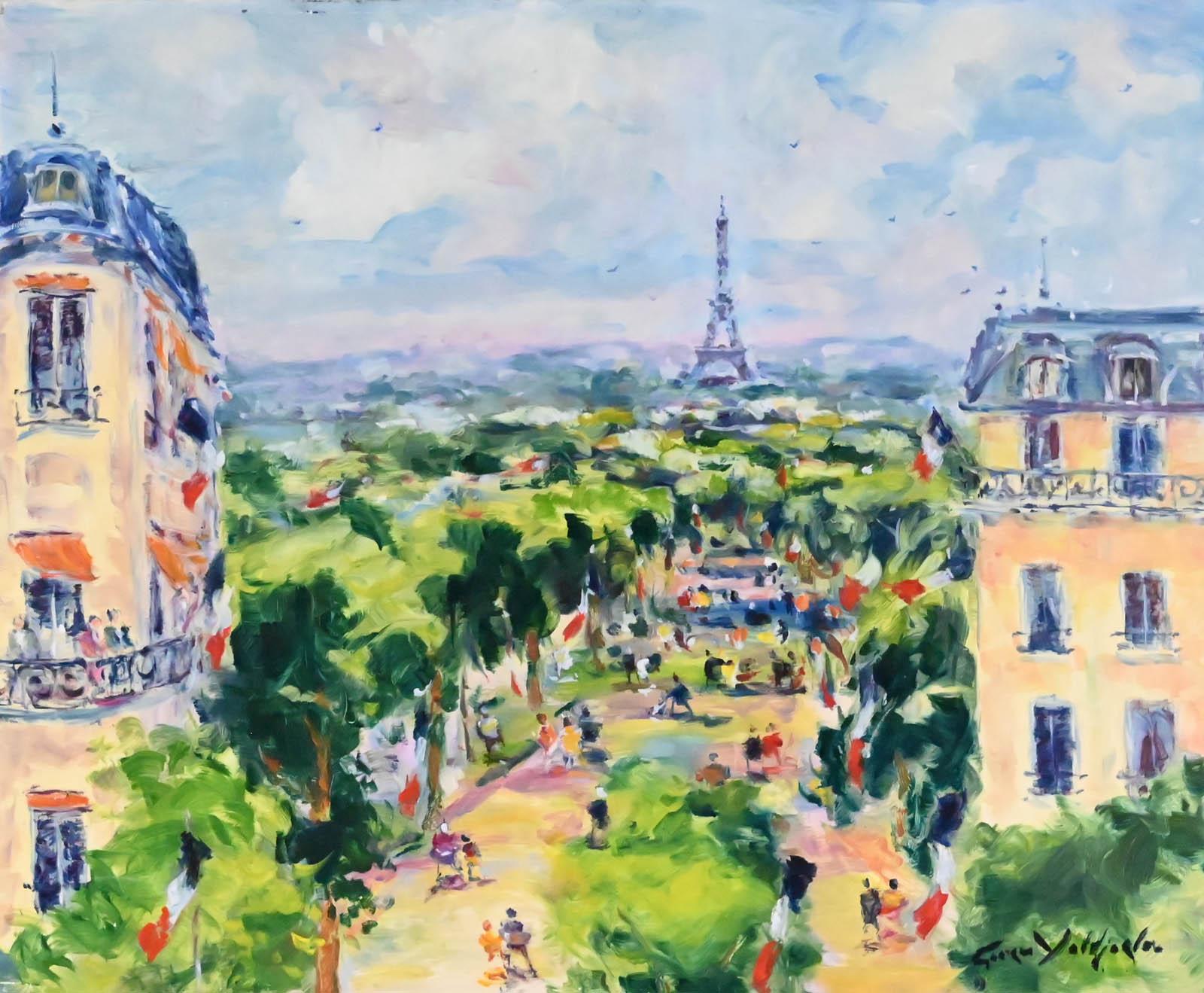Items Similar to Henri-André Martin Road in Eygalieres, Alpilles, Provence, Oil on Canvas, 1999
Want more images or videos?
Request additional images or videos from the seller
1 of 8
Henri-André MartinHenri-André Martin Road in Eygalieres, Alpilles, Provence, Oil on Canvas, 19991999
1999
About the Item
Oil on canvas by Henri-André Martin (1918-2004), France, 1999. Road in Eygalieres, Alpilles, Provence. With frame: 52x67 cm - 20.5x26.4 inches. Without frame: 46x61cm - 18.1x24 inches. Format 12P. Signed and dated lower left "Henri-André Martin 99" (see photo). Located on the back (see photo). Can be matched to make a pair with another painting by Henri-André Martin that we offer on 1stdibs whose title is "Henri-André Martin Road in the Alpilles, Provence, Oil on Canvas, 1980s".
Born in Lyon in 1918, the child and the adolescent Henri-André Martin spent his youth in Saint-Étienne, his father, Edme Martin, first installed as a practicing doctor in Lyon, having been appointed doctor of the anti-tuberculosis dispensaries of the Loire.
During his first years of studying medicine in Lyon, he nevertheless enrolled in the Beaux-Arts. Appointed hospital intern upon his return from captivity in 1942, he ended his medical career as director of the otolaryngology university clinic at Édouard-Herriot hospital. But painting was his passion.
Painting was for Henri-André Martin the way of expressing his feelings. By nature very reserved and of an extreme modesty that many took for coldness, it was what allowed him to express his strong artistic sensitivity and, his pictorial periods are as many reflects of his anxieties, of his hopes, of his joys. At every period of his life, wherever he goes and whenever he has a moment, he paints gouaches, often of small size, but sometimes of larger size. He also paints beaches that have been compared to those of Boudin. Their invoice shows, however, that this figure is only appearance and that in fact, these beaches made of water, sky and sand, readily dispense with the motif, the work of the material seeming to have more importance. as the subject. Despite the fact that until the 1970s he painted "on the ground", his canvases remain far removed from the anecdote. Often harsh like the landscapes of Provence, the Parisian walls which express concern, or the railways, the switch tracks which suggest, in ocher and black, all the embarrassment of choice. We find the same nostalgic gravity in the canvases of the carcasses of boats which, as his friend Louis Pons later wrote, "seem to die of immobility" or in the canvases of Venice, or the landscapes of Eygalières.
In the following years, his painting became simpler, more synthetic, such as these landscapes with tortured almond trees, black and gnarled olive trees, plane trees standing out against the ocher sky of the dawn of Provence, in winter. These are also the canvases of Hamburg in the dough becomes heavier, the colors darken, marking all the gravity of the port landscapes. Workshop work gradually takes precedence over motif painting.
The pivotal period coincides with that of his work on the olive tree, during which he leads the realization of the "Trunks", a collection of six lithographic plates, of the book L'olivier comprising many lithographs and serigraphs, but also texts. poetic and numerous paintings. He then became passionate about everything related to the olive tree (literature, painting, traditions, history), but also to the tree itself, its thousand-year-old history, its poetry, its symbols, but also its culture, its size. oil production and mills, a passion that he will keep for the rest of his life. This work on the olive tree allowed him to achieve wide simplifications. Hence paintings with a symbolist character, in which one has the impression that the goal is not to represent this or that tree, but to summarize in an emblem, trunk, leaf and sky, the civilization of the olive tree. René Déroudille wrote about them in 1976: "There is a lyrical sap there which carries the artist along and pushes him to define the trees of dear Provence in a different way." The ancestor "and especially the plates devoted to embrace and renewal, in poetry de fi nes the action of an artist who is also in full mutation ".
The following years were marked by intense pictorial activity and the realization in the studio and from sketches on patterns, large canvases very often colored which were the subject of a major exhibition in 1988 at the Maison de Lyon. Bernard Gouttenoire wrote in Hebdo Lyon in June 1979 on this subject: “The fields of colza or lavender abundantly filling the canvas frame. . ..There could be "monotony" by practicing large flat areas, but precisely this is not the case and we never get tired of so many sublimated colors ".
In the 1980s, Provence and especially the Alpilles, which had long been privileged themes, presented him with an intense source of inspiration and an evolution towards much more abstract canvases. These same years are marked by the realization of large nudes which with the Alpilles and other colored canvases are the subject of a major exhibition at L'Atrium in Lyon in 1992. During this period of the 1990s, he worked in the studio intensely, embarks on series, often abstract and undoubtedly necessary for its expression. René Déroudille wrote in 1992: “. . . he wants to go to the end of his work, that is to say to bring to their conclusion the shapes and colors born of his creative imagination. . . Slowly but surely, he arrived at a sort of plenitude, at the satisfaction of the task finally accomplished ... Absolutely apart from the Lyon school, he seems unpretentious, reveling in an active solitude, where he feels close to his desires ”. Gradually, however, he dealt with more attractive, almost decorative subjects, such as Japanese flowers and butterflies. It takes up old themes with a frankly figurative style: bouquets of flowers, still lifes, landscapes of Eygalières.
Prizes and distinctions
1964: Maurice Utrillo Prize
Out of competition, then medal of honor from the Société lyonnaise des Beaux-Arts
Member of the Salon du Sud-Est until his death in 2004.
Drawing and water painting fair, Paris
Member of the Salon of the National Society of Fine Arts, Paris
Member of the Salon d'Automne, Paris
Correspondent of the Institut de France
His paintings were exhibited in great galleries in Paris, New-York, Dallas, Caracas, Genève, etc.
- Creator:Henri-André Martin (1918 - 2004)
- Creation Year:1999
- Dimensions:Height: 20.48 in (52 cm)Width: 26.38 in (67 cm)Depth: 1.19 in (3 cm)
- Medium:
- Movement & Style:
- Period:
- Condition:
- Gallery Location:Saint Amans des cots, FR
- Reference Number:1stDibs: LU1088213377352
About the Seller
5.0
Vetted Seller
These experienced sellers undergo a comprehensive evaluation by our team of in-house experts.
1stDibs seller since 2018
34 sales on 1stDibs
- ShippingRetrieving quote...Ships From: Saint Amans des cots, France
- Return PolicyA return for this item may be initiated within 2 days of delivery.
More From This SellerView All
- Oil on Canvas by Jallais, Boats in Port, 1960sLocated in Saint Amans des cots, FROil on canvas by Jallais, France, 1960s. Boats in port. In its pretty dark brown wooden frame. With frame: 68x58 cm - 26.8x22.8 inches, without frame: 61x50 cm - 24x19.7 inches. 12F ...Category
1960s Post-Impressionist Figurative Paintings
MaterialsCanvas, Oil
- Henri-André Martin, Les Baux de Provence, Oil on Canvas, 1961By Henri-André MartinLocated in Saint Amans des cots, FROil on canvas by Henri-André Martin (1918-2004), France, ca.1980s. Les Baux de Provence. With frame: 71x98 cm - 28x38.6 inches. Without frame: 65x92cm - 25.6x36.2 inches. 30P format. Signed lower right "Henri A Martin" (see photo). Located and dated 1961 on the back (see photo). Can be matched to make a pair with another painting by Henri-André Martin that we offer on 1stdibs whose title is "Henri-André Martin Olive Tree Field in the Alpilles, Provence, Oil on Canvas". Born in Lyon in 1918, the child and the adolescent Henri-André Martin spent his youth in Saint-Étienne, his father, Edme Martin, first installed as a practicing doctor in Lyon, having been appointed doctor of the anti-tuberculosis dispensaries of the Loire. During his first years of studying medicine in Lyon, he nevertheless enrolled in the Beaux-Arts. Appointed hospital intern upon his return from captivity in 1942, he ended his medical career as director of the otolaryngology university clinic at Édouard-Herriot hospital. But painting was his passion. Painting was for Henri-André Martin the way of expressing his feelings. By nature very reserved and of an extreme modesty that many took for coldness, it was what allowed him to express his strong artistic sensitivity and, his pictorial periods are as many reflects of his anxieties, of his hopes, of his joys. At every period of his life, wherever he goes and whenever he has a moment, he paints gouaches, often of small size, but sometimes of larger size. He also paints beaches that have been compared to those of Boudin. Their invoice shows, however, that this figure is only appearance and that in fact, these beaches made of water, sky and sand, readily dispense with the motif, the work of the material seeming to have more importance. as the subject. Despite the fact that until the 1970s he painted "on the ground", his canvases remain far removed from the anecdote. Often harsh like the landscapes of Provence, the Parisian walls which express concern, or the railways, the switch tracks which suggest, in ocher and black, all the embarrassment of choice. We find the same nostalgic gravity in the canvases of the carcasses of boats which, as his friend Louis Pons later wrote, "seem to die of immobility" or in the canvases of Venice, or the landscapes of Eygalières. In the following years, his painting became simpler, more synthetic, such as these landscapes with tortured almond trees, black and gnarled olive trees, plane trees standing out against the ocher sky of the dawn of Provence, in winter. These are also the canvases of Hamburg in the dough becomes heavier, the colors darken, marking all the gravity of the port landscapes. Workshop work gradually takes precedence over motif painting. The pivotal period coincides with that of his work on the olive tree, during which he leads the realization of the "Trunks", a collection of six lithographic plates, of the book L'olivier comprising many lithographs and serigraphs, but also texts. poetic and numerous paintings. He then became passionate about everything related to the olive tree (literature, painting, traditions, history), but also to the tree itself, its thousand-year-old history, its poetry, its symbols, but also its culture, its size. oil production...Category
1960s Post-Impressionist Figurative Paintings
MaterialsCanvas, Oil
- Notre-Dame de Paris, Oil on Canvas by Henri André MartinLocated in Saint Amans des cots, FROil on canvas by Henri-André Martin (1918-2004), France, ca.1960. Notre-Dame de Paris. With frame: 79.3x 60.3 cm - 31.2x23.7 inches. Without frame: 54x 73 cm - 21.3x28.7 inches. 20P format. Signed lower left "Henri A. Martin" (see photo). Born in Lyon in 1918, the child and the adolescent Henri-André Martin spent his youth in Saint-Étienne, his father, Edme Martin, first installed as a practicing doctor in Lyon, having been appointed doctor of the anti-tuberculosis dispensaries of the Loire. During his first years of studying medicine in Lyon, he nevertheless enrolled in the Beaux-Arts. Appointed hospital intern upon his return from captivity in 1942, he ended his medical career as director of the otolaryngology university clinic at Édouard-Herriot hospital. But painting was his passion. Painting was for Henri-André Martin the way of expressing his feelings. By nature very reserved and of an extreme modesty that many took for coldness, it was what allowed him to express his strong artistic sensitivity and, his pictorial periods are as many reflects of his anxieties, of his hopes, of his joys. At every period of his life, wherever he goes and whenever he has a moment, he paints gouaches, often of small size, but sometimes of larger size. He also paints beaches that have been compared to those of Boudin. Their invoice shows, however, that this figure is only appearance and that in fact, these beaches made of water, sky and sand, readily dispense with the motif, the work of the material seeming to have more importance. as the subject. Despite the fact that until the 1970s he painted "on the ground", his canvases remain far removed from the anecdote. Often harsh like the landscapes of Provence, the Parisian walls which express concern, or the railways, the switch tracks which suggest, in ocher and black, all the embarrassment of choice. We find the same nostalgic gravity in the canvases of the carcasses of boats which, as his friend Louis Pons later wrote, "seem to die of immobility" or in the canvases of Venice, or the landscapes of Eygalières. In the following years, his painting became simpler, more synthetic, such as these landscapes with tortured almond trees, black and gnarled olive trees, plane trees standing out against the ocher sky of the dawn of Provence, in winter. These are also the canvases of Hamburg in the dough becomes heavier, the colors darken, marking all the gravity of the port landscapes. Workshop work gradually takes precedence over motif painting. The pivotal period coincides with that of his work on the olive tree, during which he leads the realization of the "Trunks", a collection of six lithographic plates, of the book L'olivier comprising many lithographs and serigraphs, but also texts. poetic and numerous paintings. He then became passionate about everything related to the olive tree (literature, painting, traditions, history), but also to the tree itself, its thousand-year-old history, its poetry, its symbols, but also its culture, its size. oil production...Category
1960s Post-Impressionist Landscape Paintings
MaterialsCanvas, Oil
- Luis Lopez, Oil on canvas "Beach Near Valencia", fishermenLocated in Saint Amans des cots, FROil on canvas by Luis LOPEZ, 1983, Spain. Beach near Valencia. Fishermen, fisherman. With frame: 106.7x80 cm - 42x31.5 inches ; without frame: 92x65 cm - 36.2x25.5 inches. P30 format...Category
1980s Realist Figurative Paintings
MaterialsCanvas, Oil
- French Mediterranean Provencal Oil On Canvas, Boats in Martigues, 1940-1950sBy François BernardLocated in Saint Amans des cots, FRFrench mediterranean provencal painting. Oil on canvas by François Bernard, France, 1940-1950s. Boats in Martigues, Provence. With frame : 61x111 cm - 24x43.7 inches, without frame :...Category
1950s Naturalistic Figurative Paintings
MaterialsCanvas, Oil
- Paul Collomb, Paris, Eiffel Tower, Invalides, The Beautiful View, Oil on CanvasLocated in Saint Amans des cots, FROil on canvas by Paul Collomb (1921-2010), France, 1960s. The beautiful view. Measurements : with frame: 54.5x41.2 cm - 21.5x16.2 inches, without frame: 46x33 cm - 18.1x13 inches, fo...Category
1960s Expressionist Figurative Paintings
MaterialsCanvas, Oil
You May Also Like
- A. J. Bennett - Light and Shade - Post Impressionist Painting, South Africa 1919Located in Meinisberg, CHA. J. Bennett (South African, fl. Early 20th century) Light and Shade • Oil on canvas artist board ca. 42.5 x 29.5 cm • Later frame ca. 53.5 x 41 cm Worldwide shipping is complime...Category
1910s Post-Impressionist Figurative Paintings
MaterialsCanvas, Oil, Board
- Ernst LINCK (1874 - 1935) Farmhouse with Clothesline School of Berne SwitzerlandLocated in Meinisberg, CHErnst Link (Swiss, ∗ 14th of October, 1874 in Windisch, † 29th of June, 1935 in Bern) Stöckli with Clothesline • Oil painting on canvas approx. 25.5 x 26.5 cm • Pine frame approx. 34.5 x 35.5 cm (obvious signs of age) • Signed lower right A most pleasant depiction of a typical ‘Stöckli’ in bright sunshine with the a few shirts on the washing line, somewhere in the Canton of Berne in Switzerland. Such small cottages would sit next to the large farmhouses and upon retirement the old couple would move into it, to make room for the next generation to take up residence in the main building and run the farm. The Painting is in pleasingly good and clean condition, with no damage or restoration Ernst Linck was an important representative of the "Berner Schule" (Bernese school) led by the famous Ferdinand Hodler, which also included Traugott Senn, Emil Cardinaux, Eduard Boss...Category
Early 1900s Post-Impressionist Landscape Paintings
MaterialsOil, Canvas
- Vieux MontmartreLocated in LE HAVRE, FRLyne SEYBEL (1919-2009) Vieux Montmartre Oil on canvas Size: 61 x 50 cm Signed lower left In perfect state of conservation. Without frame Provenance: Family of the artist Painting...Category
1960s Post-Impressionist Landscape Paintings
MaterialsCanvas, Oil
- Le port de DieppeBy Jacques BouyssouLocated in LE HAVRE, FRJacques BOUYSSOU (1926-1997) Le port de Dieppe, 1969 Oil on original canvas, in perfect condition, original canvas. Large size : 90 x 118 cm Signed lower left Vintage frame Provena...Category
1960s Post-Impressionist Landscape Paintings
MaterialsCanvas, Oil
- Neige à Saint Martin de BoschervilleLocated in LE HAVRE, FRLouis Jacques VIGON (1897-1985) Neige à Saint Martin de Boscherville Oil on canvas Size: 60 x 81cm Signed lower left. Titled on the back Provenance : - Tuffier Gallery, Les Andelys...Category
Mid-20th Century Post-Impressionist Landscape Paintings
MaterialsCanvas, Oil
- Tempête à HonfleurLocated in LE HAVRE, FRLyne SEYBEL (1919-2009) Tempête à Honfleur Oil on canvas Size: 65 x 92 cm Signed lower left. In perfect state of conservation. With beautiful frame Provenance: Family of the artist...Category
1960s Post-Impressionist Landscape Paintings
MaterialsCanvas, Oil
Recently Viewed
View AllMore Ways To Browse
Maison De Provence
Slow Roads
Where Is 1stdibs Located
Vintage Martin Case
Vintage Medical Case
Tree Sap
Saint Louis Colored
Vintage Old Trunk
Frans Francken The Younger
Everett Raymond Kinstler
E Flack
Two Faced Woman
Banana Figure
Market Scene Oil Painting
Vintage Board Track Racing
V Bergen
Cuban Necklace Woman
La Piazza





